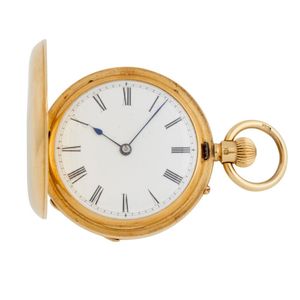1890 18ct Gold Hunting Cased Pocket Watch with Heraldic Shield
18ct gold hunting cased pocket watch circa 1890, dial: white enamel Roman, spade hands, movement: English lever, crown wind, pin set. Case: polished hinged engraved with heraldic shield in Latin, the cuvette with presentation inscription, to Florence from field, 30th April, 1888. Signed: movement signed by retailer Walsh Bros Melbourne, numbered 91016. Dimensions: 37 mm diameter. Accessories: Hardy Brothers Goldsmiths & Jewellers fitted presentation box
You must be a subscriber, and be logged in to view price and dealer details.
Subscribe Now to view actual auction price for this item
When you subscribe, you have the option of setting the currency in which to display prices to $Au, $US, $NZ or Stg.
This item has been sold, and the description, image and price are for reference purposes only.
- Circa - A Latin term meaning 'about', often used in the antique trade to give an approximate date for the piece, usually considered to be five years on either side of the circa year. Thus, circa 1900 means the piece was made about 1900, probably between 1895 and 1905. The expression is sometimes abbreviated to c.1900.
- Crown Wind - A winding method for a watch, using a knurled or fluted knob, located at 3 o'clock on a wristwatch and 12 o'clock on a pocketwatch.
- Heraldic Decoration - Heraldic decoration on silver, glass, and porcelain refers to the use of coats of arms and other heraldic symbols as decorative motifs on these materials. Coats of arms were traditionally used to identify individuals, families, and institutions, and were often displayed on shields, banners, and other objects.
The heraldic decoration typically takes the form of engraved or etched designs that incorporate coats of arms or other heraldic symbols. Heraldic decoration on silver, glass, and porcelain has a long history, dating back to the medieval period when coats of arms were first used. During the Renaissance and Baroque periods, heraldic decoration on decorative objects became increasingly elaborate and ornate, with finely detailed designs that often incorporated intricate scrollwork, mythological figures, and other decorative motifs.
In the 18th and 19th centuries, heraldic decoration became particularly popular among the aristocracy and upper classes, who used these objects as symbols of their wealth and status. - Movement - The technical name for the workings of a clock or watch, and does not include the dial or case.
This item has been included into following indexes:
- Hardy Bros. (Australia) - pocket watches 30
- pocket watches, case type
